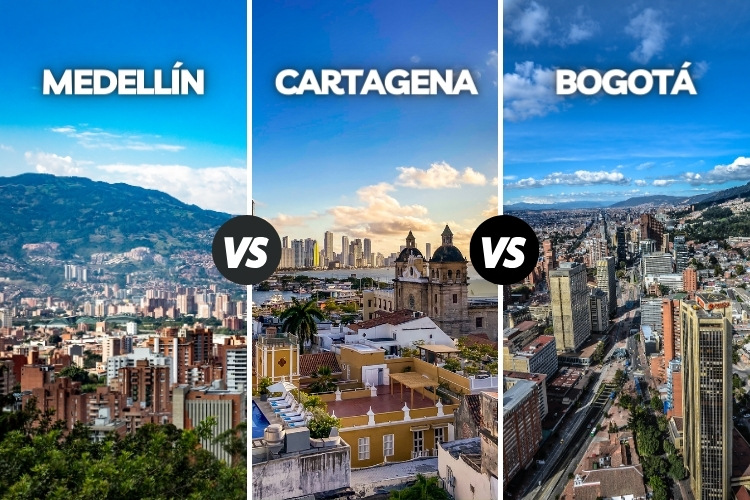The three most popular cities for foreign visitors to Colombia are Cartagena, Medellin and Bogota. While there are some shared characteristics there are also massive differences in climate, culture, food, music, history, shopping, amenities, activities and local lifestyles.
I have lived in Medellin for almost fifteen years and visited Bogota and Cartagena regularly for work and vacations. I love all three and I will try to explain why to help you see which is best for you.
No time to read it all? Here are my quick recommendations
- The best city for a weekend break: Cartagena is perfect for a short break – day out on the islands, delicious seafood, spectacular sunsets and wild parties
- The best city for food and restaurants: Bogota has the best variety of really top restaurants although Cartagena has great seafood and Medellin has some good options too.
- The best city for day trips: Leave the valley of Medellin and you will find amazing waterfalls, quaint villages, cool rivers and incredible landmarks such as El Peñón de Guatapé.
- The best city for exploring: While the charms of Bogota may not immediately jump out like its rivals, the huge city has so much culture, style and personality to be discovered.
- The best city for a warm welcome: Medellin has the friendliest people of any city I have ever visited
- The best city for fascinating history: Every corner of Cartagena’s old town is beautiful and filled with amazing history. Medellin and Bogota have a lot of landmarks but you live the history of the historic center of Cartagena.
- The best city for nightlife: Sunsets and cocktails in Cartagena are great, Bogota has the best variety but rooftop drinks and wild reggaeton in Medellin takes it for me.
Sightseeing and Attractions: Medellin vs Cartagena vs Bogotá
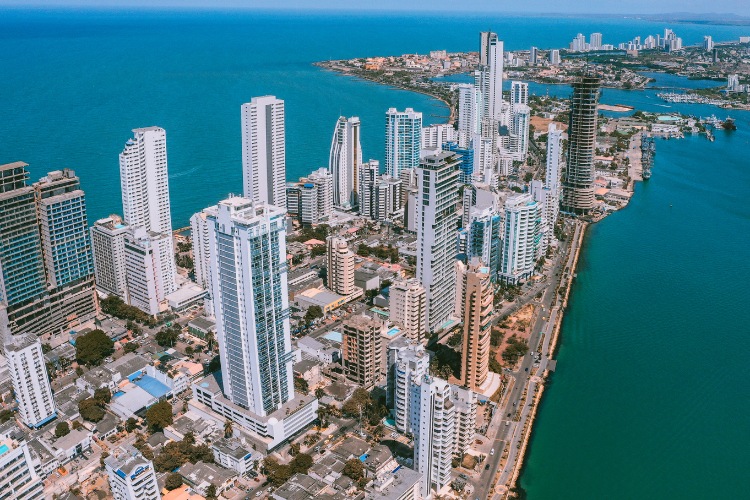
Each of the cities offer something very different in terms of highlights with this opening category.
Cartagena stands out for the beaches, the islands, the Spanish colonial architecture of the old town and the beautiful sunset views. The beaches close to the historic center and Bocagrande, an upmarket strip with hotels, are fine but not spectacular. They can be quite crowded and are filled with a lot of aggressive sellers which can damage the experience.
If you take a boat from the marina you can travel to dozens of islands with excellent beaches. You can go on a day trip and return or on islands such as Isla Grande spend the night in a very peaceful setting. Isla Grande has no cars and you can comfortably walk around exploring the trails and beaches. Other beaches have drinks, music and parties if that is more your scene.
Bogota has a huge amount of variety and options if you plan your time well. You can travel up to the peak of Monserrate, which is a high mountain that overlooks the city with spectacular views. There is a cable car or you can climb the 1,500 stairs to the 10,000 feet peak if you are feeling really fit.
The gold museum is very popular and there are a lot of important historic buildings wandering around La Candelaria to the main Plaza de Bolivar.
While Medellin isn’t as large as Bogota, the capital of the Antioquia state has a lot of variety on offer. Downtown you will find churches, picturesque squares such as Plaza Botero, filled with statues by world-famous artist Fernando Botero.
You can travel up to the hills of San Antonio neighborhood on the cable car with amazing views of the city or enjoy the graffiti, music and vibrant culture of Comuna 13. While the city is densely populated within the valley, a short trip beyond you will find lush green nature and a great range of activities including rafting, horse riding, paragliding and the incredible rock in Guatape.
In terms of an immediate wow factor, I would give this to Cartagena. The beautiful architecture of the old town and boat trips to the island are really special. That said, I think you can experience the best of Cartagena in a week while Medellin and Bogota have a far greater variety of attractions on offer. Bogota requires more planning and exploration while Medellin is packed full of fun activities for visitors.
Safety: Medellin vs Cartagena vs Bogotá
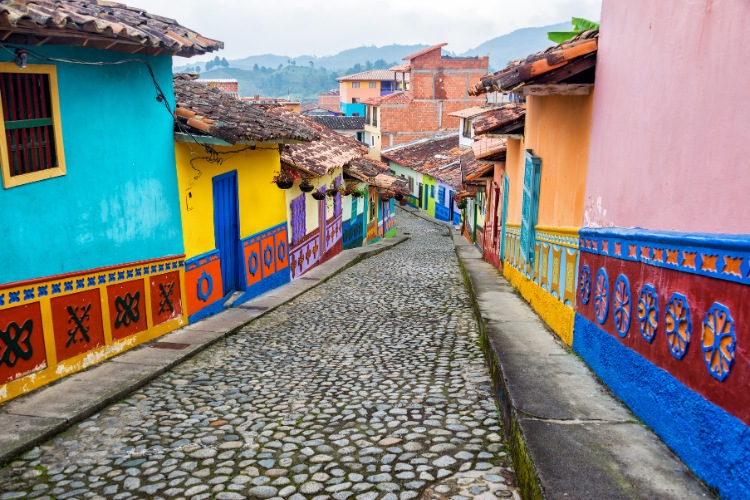
All three cities have similar challenges in terms of safety. This is something to be cautious of but shouldn’t be blown out of precaution – don’t be scared about visiting Colombia but do take care to avoid any problems. Don’t ‘dar papaya’ – to ‘give papaya’ is weirdly local slang for ‘set yourself up to become a victim’.
Cartagena has a huge number of national and international tourists. This means a lot of people with money come into a city with a lot of poverty and inequality. Obviously, that means there is the potential for problems but there are a lot of police and Bocagrande (the main beach area) and the historic center are well policed.
In Cartagena, you need to take care predominantly for robberies and pickpockets. You also need to be careful about scams and being massively overcharged. Most of the crime in Cartagena is the type of small-scale theft you would expect in any popular tourist city.
Medellin sits in a big valley with most of the poorer neighborhoods up high into the hills. Those areas can be dangerous but tourists will only really go there for tours. El centro is actually the area with the most crime and violence but this occurs at night and tourists should be fine in the day if they take care.
In Medellin, the most likely crimes are robberies and petty theft. There have been well-publicized cases of scopolamine poisoning and you should be careful with your drink to make sure nothing is spiked. If you get involved in drugs and prostitution then that can of course open up further risks.
The situation in Bogota is similar. Theft and robberies, particularly in La Candelaria which is a central area popular with backpackers and tourists. While downtown Medellin is avoided at night, La Candelaria is more populated but caution is advised.
The same issues largely exist in all three and the same advice applies. In my experience, Cartagena feels the safest followed by Medellin and then Bogota. The homicide rate in Bogota, for example, is lower but street crime, something that is more likely to impact on foreign visitors, is higher.
Climate and Weather: Medellin vs Cartagena vs Bogotá
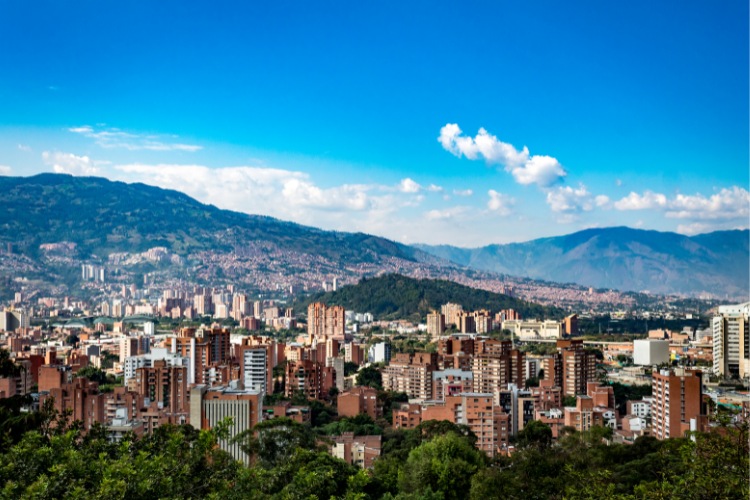
Medellin is known as ‘the city of eternal spring’, Cartagena offers year-round summer heat with some tropical downpours and Bogota can surprise with four seasons worth of weather in a single day.
Personally, I find Medellin by far the most comfortable with one of the most pleasant climates of anywhere I have visited. It is never really cold and while the sun can be bright, the heat is never overly intense. Average temperatures are typically between 17°C (62°F) and 28°C (82°F). December to March are the drier months but, while the rain can be very heavy, it usually clears within a couple of hours.
Basically, Medellin is almost always warm enough to swim outdoors but rarely too hot to leave you sweating in the shade. Personally, to me, that is perfection.
Cartagena is on the Caribbean coast and provides year-round summer temperatures. From December to April, it can be drier but you often get very heavy downpours with October the wettest month. Temperatures will go above 30°C (80°F) throughout the year with averages in the high 20s up to mid 30s.
Cartagena is perfect beach weather but be prepared to be drenched in the occasional monsoon which leaves much of the city flooded for days.
Bogota, sitting at 2,600 meters high in the Andes, has very different weather. While the sun can feel strong at the altitude, the weather is rarely particularly warm. Temperatures range from 7°C (44°F) to around 20°C (68°F) throughout the year. Throughout the day the weather can vary hugely; you can leave your house in a t-shirt with clear skies and perfect sunshine and return home freezing with enormous hailstones setting off all the car alarms with apocalyptic fury.
The weather in Bogota is often pleasant and comfortable enough but remember to always have a jacket and an umbrella ready. Failing to plan is planning to inevitably end the day wet and frozen. To quote the excellent song by Aguas Ardientes, Bogota is “una chica bipolar, hace calor antes de granizar” (Bogota is a bipolar girl, hot before it hails).
A weekend on the beach in the sun of Cartagena is amazing but Medellin’s eternal spring takes it for me. The rain can potentially ruin your plans in Medallo but the temperature is basically pure perfection.
Culture and History: Medellin vs Cartagena vs Bogotá
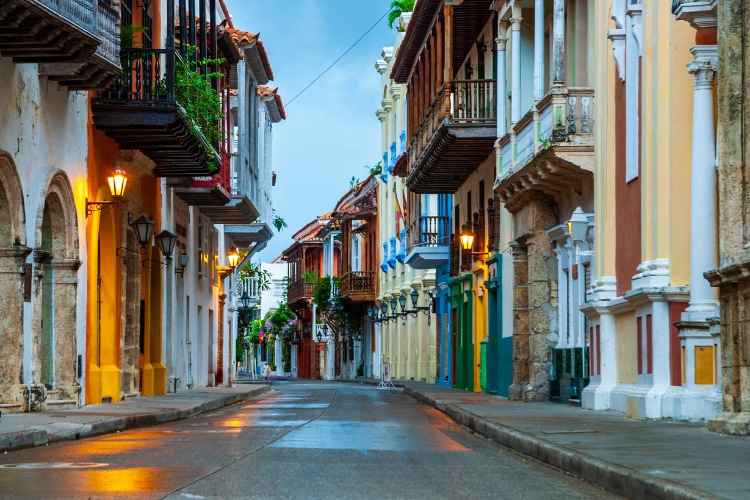
All three cities have a lot to offer on this but there are some notable differences.
Bogota is great in terms of museums, galleries, art and music. The culture is very diverse in Colombia’s huge capital and you will find a great deal of variety. The city has embraced influences from all over the country while also developing a unique identity.
La Candelaria has lots of important historic buildings, architecture and charm.
Medellin combines the classic rural Antioquia culture with modern, cutting edge style. There are many contemporary and historic museums as well as graffiti tours, modern art installations and live musical performances.
To get a sense of Medellin’s history, you can visit the historic churches downtown or explore the recent transformation in Comuna 13 and the Memory House Museum.
While you have to search out the history of Medellin and Bogota, you will experience it throughout your visit to Cartagena. The historic center is surrounded by an 11km wall built in the sixteenth century by the Spanish. The streets of the old town are beautiful with a classic design that has been unchanged in centuries.
I would strongly recommend walking tours in all three cities as these give an amazing insight into the history of each city and key landmarks.
For history and beauty, I have to give this to Cartagena. Bogota offers a very rich and varied culture but Cartagena is a really special place.
Transportation: Medellin vs Cartagena vs Bogotá

This is a very simple one; Medellin’s transport network is generally superb, Cartagena’s is a little ad hoc and inadequate while Bogota’s is almost non-existent despite 80 years of plans and promises.
The modern, elevated Medellin Metro was opened in 1995 and now features two lines, six integrated cable cars, a tram system and MetroPlus, a Bus Rapid Transit network with dedicated stations and lanes. In terms of public transport, Medellin is one of the most advanced cities in Latin America. You can get from the top of the valley down in a cable car, cross the city in the Metro and then go up the hills to the east on the tram by just purchasing one US$.80 ticket.
The major roads in Medellin are wide and well maintained, although they can become overly steep and narrow up until the poorer neighborhoods on the hills. Taxis and Uber are everywhere and very affordable. You can even take a free public escalator to climb the hills of Comuna 13.
Bogota announced the city would construct its first metro line in the 1940s. Construction began on the first metro line in 2020 and is allegedly set to be completed in 2028. Bogota (7.2 million) isn’t a great deal smaller in terms of population than London (8.9 million), imagine removing the Underground from the UK capital and the resulting chaos. Welcome to Bogota at rush hour.
Bogota has the Transmilenio, a BRT system with stations and dedicated roads, and buses. There are plenty of Ubers and taxis but the roads are very slow and unpredictable. I have friends who can get to work in 20 minutes one day and over an hour the next. I never organize more than 2 meetings per day in Bogota because crossing the city is slow and painful.
Cartagena has limited public transportation offerings but for tourists and visitors this doesn’t usually matter. From the airport, you will take the coastal road to your hotel on the beach in Marbella or further along in the old town or round the corner onto Bocagrande.
The total population of the city is around 1 million but the vast majority of visitors will travel along 3 or 4 wide main roads and then lots of small, walkable roads within the historic center. Taxis and Ubers are always available with fair pricing. There is also the Transcaribe BRT, a bus with dedicated stations and road, that links the key areas plus conventional buses.
Transportation in Cartagena is limited but for most visitors, it will be fine. You can quickly and easily take public transportation to almost anywhere in Medellin while transportation is a constant headache in Bogota. Medellin definitely takes this one.
Cost of living: Medellin vs Cartagena vs Bogotá
The first thing to say is that, given the devaluation of the Colombian peso in recent years, you are likely to find life in all three cities pretty cheap. The dollar has gone from around 2,000 COP to just over 4,000 COP in the last ten years. The same applies to pounds and euros.
There is a huge difference between the cheaper and more expensive areas of the city. The minimum monthly wage in Colombia is US$285, which means at least in theory this is enough to live on in Medellin, Cartagena and Bogota. Of course, as a visitor or digital nomad, you are likely to focus on the most expensive areas, at least initially.
Accommodation in Cartagena in popular tourist areas can be the most expensive, particularly in Bocagrande or in and around the historic center. There is always high demand and a limited number of options in those parts of the city.
Visitors from all over Colombia and internationally come to the city which can mean restaurants and bars can also charge a little more, knowing there will always be demand, particularly in the busy times of the year. Outside of the tourist areas, Cartagena can be the cheapest of the three but most won’t want to stray too far from that side of the city.
While not yet to the same extent, the cost of renting and accommodation in Medellin has been pushed up in the more expensive areas by international visitors. Poblado and Laureles have seen prices rise significantly in recent years.
That said, if you make smart decisions, you will generally find Medellin very affordable beyond the top end luxury restaurants, bars and stores.
Bogota is on average considered the most expensive of the three but international visitors and migrants will find a greater range of suitable areas to stay than in Cartagena. Prices can also be a little higher in general but again with time, you will find ways to make savings.
For most foreign visitors Cartagena will be the most expensive followed by Bogota and Medellin although that will depend on choices. Furthermore, it is important to emphasize that all will feel very cheap for someone coming from London or New York, for example.
Nightlife: Medellin vs Cartagena vs Bogotá

The typical music, culture, bars and clubs of each city again have some similarities but also important differences.
Medellin is one of the global capitals of reggaeton with bestselling superstars J Balvin, Maluma and Karol G coming from the city. Reggaeton is popular across Latin America but it is great to party in the city which is at the heart of the musical movement. While this is the genre that has defined the city in recent years, you will still find salsa, merengue, vallenatos, bachata on heavy rotation as well as electro, hip-hop, dancehall, pop, rock and afrobeat.
Poblado has some excellent, open-air rooftop bars overlooking the city serving delicious cocktails and good food. Poblado and Laureles are the most popular areas for visitors but Envigado, Buenos Aires, Itagui and Bello have a lot to offer once you get settled in.
Cartagena has a nice mix of hot and lively raves mixed with elegant, sophisticated bars and clubs. You can start your evening at Cafe del Mar or a rooftop bar with some cocktails overlooking the sea as the sun goes down. There is live salsa at Cafe Havana, which has a classic 1950s Cuban-style feel.
The city has all of the music mentioned above but also some sounds which have a special resonance in the coastal region. The accordion-fueled Vallenato music, originating in the town of Valledupar, is popular as well as champeta, an energetic Colombian genre of music with West African roots.
Bogota has bars offering music from around Colombia but also has bars and clubs with a bit more of an edge. You will find a bit of everything in the capital with people migrating from across the country and bringing the influence of their own culture. Alongside that, you have the creative, stylish feel of the capital.
As you would expect, you can enjoy anything from fancy bars and clubs to grimey warehouse raves in Bogota with the style and sounds coming in all flavors.
This one is another tough one. Bogota has greater variety and offers some of the unexpected, Cartagena is pure beach vibes with some old-town elegance while Medellin is a bit of reggaeton perreo after some rooftop cocktails.
Food and Cuisine: Medellin vs Cartagena vs Bogotá
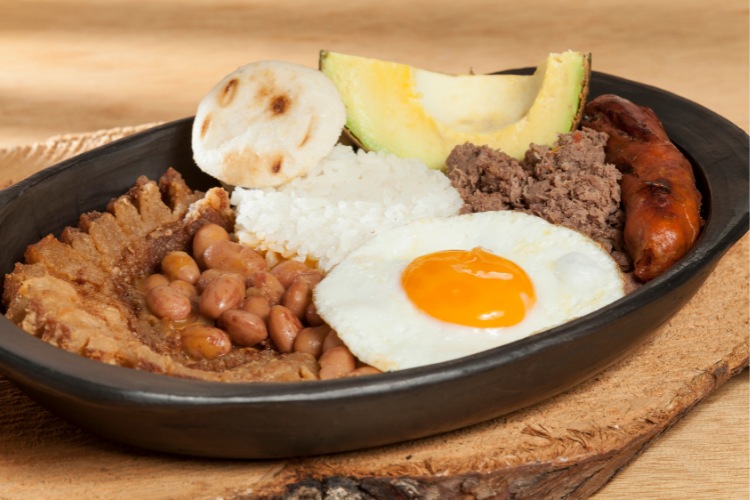
The typical dishes of each city are reflective of the region, culture and climate.
Cartagena is famous for amazing fresh fried fish, seafood casserole, garlic shrimp, fish soup, ceviche, coconut rice, double fried plantain and egg filled arepa. Everything is very fresh and the best food is the embodiment of coastal living.
There are some fancy top-tier restaurants with elegant decor as well as some hidden spots with local favorites. Lots of quality options and if in doubt go for the recommended seafood options.
Medellin’s popular dishes are linked to the rural farming history of the region. Big, hearty filling food which will set you up for the day or reward you for a good day’s work in the fields. Bandeja paisa is a dish synonymous with Medellin, featuring piles of beans, rice, arepa, chorizo, plantain, chicharrón, avocado, a fried egg and ground beef.
Other popular local foods include morcilla (blood sausage), sancocho (meat and vegetable stew), kidney beans and arepa. Always arepa with everything. Again, Medellin has elite-level dining as well as fried street food and hidden gems with great prices.
Bogota offers great comfort food to warm you up and make everything right again on a chilly evening. Ajiaco Soup is the city’s signature dish made of chicken, potatoes, herbs, corn, and avocado with a side of rice to mix in. Bogota also has great tamales, something popular across Colombia, with ingredients such as rice, corn flour and chicken wrapped up in plantain or banana leaves.
Changua is another popular soup as well as caldo, a meaty broth that is the perfect hangover cure. You can wash that down with herbal tea or hot chocolate with cheese tipped in. I know but really it is actually nice, you should give it a go.
Bogota has a huge range of excellent local and international restaurants. While the typical local food follows a theme of soothing comfort food, you can find the greatest range of options in the city.
The typical food offerings of each are perfect for their setting. If you can smell the sea air of the Caribbean then a seafood casserole is ideal, if you are need warming in the altitude of the Andes then a tasty soup if perfect and if you want to hike the mountains of Medellin, what could be better than a plate full of meat and carbs.
While each is great, I lean towards Bogota for the variety and quality of restaurants that go beyond the local favorites.
Local Hospitality and Friendliness: Medellin vs Cartagena vs Bogotá

Colombian people are amazing and that applies to the residents of all three cities. That said, there are very clear and pronounced cultural differences.
People in each of these cities speak with different accents, eat different food, experience different weather, listen to different music and live different lives. In recent decades with the expansion of the road network and affordability of flying there is far more mixing but Colombia has a deeply distinct region with unique histories.
Rolos (slang for people from Bogotá), Paisas (those form Medellin and Antioquia) and costeños (people from the coast) all have a unique charm.
In Cartagena, people speak much quicker and it can be a challenge to follow even for experienced Spanish speakers. The stereotypical costeño is fun, expressive, loud and enthusiastic. In my experience, the locals love to drink some rum, have a dance and listen to vallenatos, reggaeton, champeta.
Once you connect with the locals then they can be great but given the huge number of foreigners in the city, massive inequality and social divisions there can sometimes feel like an “us and them attitude”. Millions of people arrive with dollars each year and a lot of people do very well or just about get by selling them stuff.
There are a lot of great people but as a foreigner or even a Colombian with a different accent you can sometimes feel excluded and that you have to keep your guard up when interacting with locals. Walking around Bocagrande hundreds of people will try to aggressively sell me boat trips or cans of beer or sombreros or grab my arm and then demand payment for a hand massage.
The people of Medellin are well and truly an absolute chimba (widely used local word for something great or cool which actually derives from informal paisa slang meaning vagina).
With expressive lilting accents, warmth, generosity, style and confident charisma, paisas have to some extent become the internationally recognized idea of what Colombians are like. Medellin is the international capital of reggaeton music and a popular setting for soap operas, so that distinct accent has become the Colombian accent for many abroad.
Paisas are stereotypically perceived to be charming sweet talkers who can win you over with a bit of panache, a cheeky grin and a “qué más pues?”. Pues is an essential part of paisa lingo – it means absolutely nothing in almost all contexts but is also completely essential. Pues.
If you wanted to be less generous you could call paisas slick-talking chancers who shouldn’t be trusted. Dell Boys with mullets if you will, for any British readers. But people who think that way are just jealous rolos who don’t know what they are talking about. Pues.
The people of Bogota can sometimes come across as cooler and a little more sophisticated in a sort of European way. The capital has lots of culture and a less brash, more assured style. The city is huge and varied with local people and migrants finding their spot, their culture, their scene.
While paisas have to shout about why they are the best, Bogotanos feel that is all a bit uncouth. “If you don’t get it, then you don’t get it – I am not going to explain it to you”.
People in Bogota are generally far more reserved and it can be harder to create a connection. Locals are less forthcoming but are polite and once you begin a conversation then you will find lots of amazing people.
Perhaps I showed some of my paisa bias here. I don’t think you can beat the warm, friendly, charming paisas but I can see the appeal of the fun, expressive costeños or the thoughtful, more aloof, stylish Bogotanos. Everyone is great (but Medellin is the best).
Shopping: Medellin vs Cartagena vs Bogotá
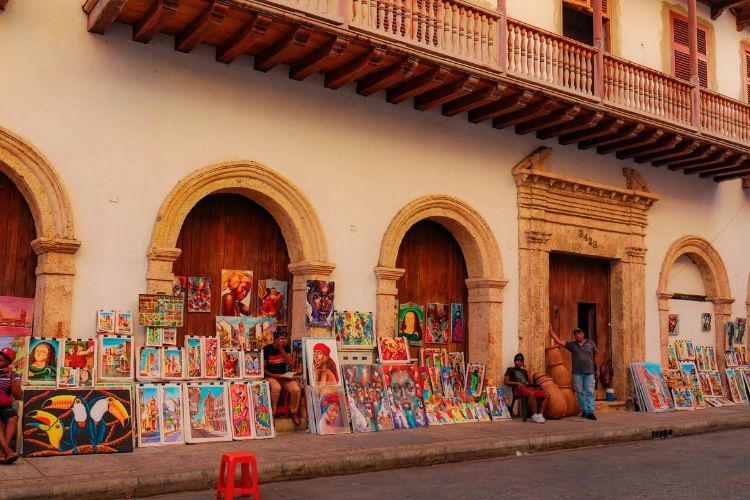
All three cities have similar large, modern malls with amenities and stores full of international brands. You can expect cinemas, restaurants, children’s activities, bars and elegant modern designs in all three. If you want something comfortable and high end, then all three will offer what you need.
You can find some real bargains if you venture downtown in Medellin to ‘el hueco’. The area runs between San Antonio to Cisneros metro stations with thousands of stores and stalls offering all sorts for cheap prices. You won’t find many artisanal works of arts but you will find a lot of everything. Bartering is definitely viable here in most stores.
In Cartagena, it can sometimes feel that everyone you meet is trying to aggressively sell you a product or a service. The city has a huge number of tourists plus day visitors on cruise ships which means unlimited opportunities to rip off naive foreigners and flog them all sorts of tat.
In Cartagena, you always have to ask and double-check the price of everything. There are stories of tourists getting into altercations on the beach because their fish and rice is inexplicably going to cost them the annual GDP of a mid-size country.
You will never be short of souvenirs in Cartagena and you can find some excellent pieces at good prices but buying anything is usually exhausting.
Bogota is probably the best option for shopping. You have the big malls and all the major brands but you also have independent artisans and street markets offering some really unique products.
I would recommend visiting flea markets to find some great prices on some vintage goods and local products. You can try Mercado de las pulgas en Usaquén, San Alejo or Pasaje Rivas. The latter is a bit rough around the edges but a great spot to find bargains.
Conclusion: Which is Better? Medellin or Cartagena or Bogota
While each of these great cities have amazing qualities, I have chosen Medellin and I can’t see myself ever wanting to leave. Medellin is comfortable, the culture is rich, the transport works, the people are friendly, the weather is perfect, security is rarely an issue and there is so much to do.
I have visited over 100 cities in my life and I can honestly say Medellin is my favorite.
Cartagena is great for a few days on the beach, Bogota has so much culture to experience but Medellin is Medellin. There is nowhere better.
